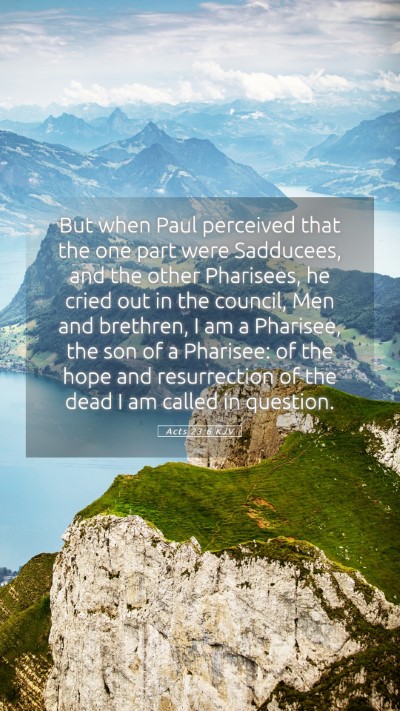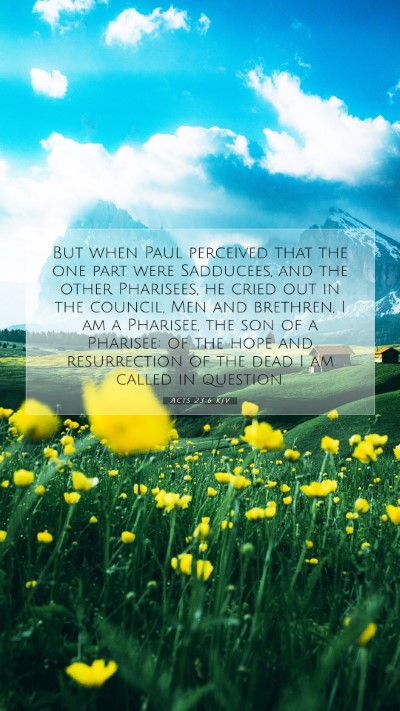Understanding Acts 23:6
Acts 23:6 states: “But when Paul perceived that the one part were Sadducees, and the other Pharisees, he cried out in the council, Men and brethren, I am a Pharisee, the son of a Pharisee: of the hope and resurrection of the dead I am called in question.” This verse illustrates the cleverness of Paul in addressing his accusers, providing a significant turning point in his defense.
Bible Verse Interpretation
In this verse, Paul identifies himself as a Pharisee, a member of a Jewish sect known for its strict adherence to the Law and belief in the resurrection of the dead. Paul strategically uses this information to create division among his accusers, which consisted of both Pharisees and Sadducees. Understanding this differentiation is essential for grasping the dynamics at play in Paul's trial.
Commentary Insights
- Matthew Henry: Henry emphasizes Paul’s shrewdness in utilizing the doctrinal divide to his advantage. He notes that the resurrection was a contentious topic, creating a diversion that shifted focus from Paul to the arguments between the two groups.
- Albert Barnes: Barnes provides clarity on the factions of the Pharisees and Sadducees, highlighting their beliefs contrasting views on resurrection and angels. He discusses how Paul’s statement was both a defensible position and a statement of faith that aligned with Pharisaical beliefs.
- Adam Clarke: Clarke highlights the personal background of Paul, noting the significance of his lineage as a Pharisee. He underscores that Paul's identity legitimized his influence and presented a compelling narrative to the council.
Bible Study Insights
This incident underscores the importance of context in biblical analysis. Understanding the historical and theological backgrounds of the groups involved enhances comprehension not just of this verse, but also of the broader narrative within Acts. This can be applied in Bible study groups where discussions may revolve around divisive issues faced by early Christians.
Historical Context of the Verse
To appreciate Acts 23:6 fully, one must consider the historical environment in which Paul was speaking. The division between Pharisees and Sadducees was more than just theological; it represented deep cultural and political tensions in first-century Judea. This context is crucial for interpreting how Paul's defense resonates within the larger framework of early Church history.
Application of the Verse to Daily Life
Acts 23:6 offers several lessons for contemporary believers:
- Wise Communication: Paul’s approach teaches us the importance of being strategic in difficult conversations, recognizing the beliefs and motivations of others can lead to more productive outcomes.
- Faith in Adversity: Maintaining faith, even when facing challenges or persecution, echoes the essence of Paul’s proclamation about the hope of resurrection.
- Emphasis on Unity in Diversity: The clash between differing beliefs shows the tension that can arise within the faith community, urging believers to seek unity amidst diversity.
Bible Cross References
This verse has several associations that provide greater context and clarity:
- Matthew 22:23-33: In this passage, Jesus discusses the resurrection with Sadducees, highlighting the theological divide.
- Acts 24:21: Paul reiterates his belief in resurrection as a cornerstone of his faith.
- Philippians 3:5-6: Paul discusses his heritage as a Pharisee, illustrating his deep roots in the faith tradition.
In-Depth Bible Verse Analysis
This analysis of Acts 23:6 shows the layers of meaning that can be extracted from seemingly straightforward statements. The historical context, doctrinal divisions, and Paul's clever defense serve as key components in understanding this scripture effectively.
Conclusion
In summary, Acts 23:6 is rich with meaning and importance, serving not only as a moment of defense for Paul but also as a showcase of the complexities within the early Christian movement. Through understanding this verse, one can appreciate the nuances of early Christian theology, the challenge of faith in adversarial environments, and the timeless lesson of shrewdness in discourse.


